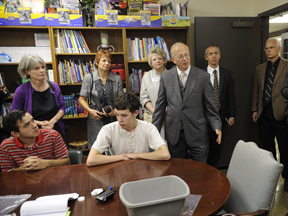A German delegation of science education, business and government officials visited Alabama July 13 to meet with Gov. Robert Bentley and State Superintendent of Schools Joe Morton and to review UAB’s Alabama Math, Science and Technology Initiative (AMSTI) program.
 |
| A German delegation of science education, business and government officials visited UAB to review the Alabama Math, Science and Technology Initiative (AMSTI) program. |
“We probably have six or seven internationals and several U.S. educators visit each year and consider the success of our model and contemplate if they should duplicate any of it back home,” says Michael Wyss, Ph.D., director of the Center for Community OutReach and Development (CORD). “The idea that a model in part germinated at UAB could be used throughout Europe is impressive. If they would pick up on this, it would be the largest group yet to have adopted the AMSTI model.”
Earlier this year, Professor Petra Skiebe-Corrette of Freie Universität Berlin heard Alabama State Department of Education Director Steve Ricks give a presentation on the AMSTI program to European education, business and governmental leaders who are part of the Fibonacci Project. The Fibonacci Project includes members from 21 countries that are working to expand inquiry-based math and science education in primary and secondary schools in Europe.
“Participants were astounded at the size and quality of AMSTI and the services it provides to your teachers and students,” Skiebe-Corrette wrote in a letter to Morton in March. “While many of our countries are working to expand effective math and science education, it appears that Alabama has found an effective model for accomplishing this through AMSTI.”
A Blue Ribbon Committee comprising lead teachers, administrators, higher education representatives and business leaders designed AMSTI, and it was formed in December 2000. The initiative, which was based on research of best practices for math and science, strongly supports national and state standards. AMSTI research has shown that students attending AMSTI schools in Alabama are scoring higher in math and science than students who do not.
AMSTI is rooted in providing three basic services to help K-12 students learn by doing math and science:
- Comprehensive professional development for teachers
- All equipment and materials needed to deliver high-quality, activity-based instruction
- On-site, regular support providing mentoring and follow-up assistance to individual teachers in inquiry instruction by math and science specialists
Skiebe-Corrette says implementing math and science reform in their areas has been a difficult and arduous task. He was impressed that AMSTI has been able to accomplish this through its program.
“Alabama has created an excellent program that greatly benefits students and has been uniquely successful in scaling the AMSTI initiative,” he says.
AMSTI infuses excitement into area K-12 math, science and technology teachers and students. AMSTI has 11 sites at colleges and universities throughout the state, and AMSTI-UAB serves all of Jefferson County and is operated through CORD.
Area schools are considered official AMSTI-UAB schools when 80 percent of teachers and administrators agree to participate and send their math and science teachers and administrators to the AMSTI-UAB Summer Science Institute for two summers.
“We encourage area teachers to be more of the guide on the side, instead of the sage on the stage,” says Karen Wood, director of AMSTI-UAB. “We try to change the teacher’s behavior in the classroom and make science more of a verb, with more active, hands-on participation by students. In this way, we provide children with experiences in which they are encouraged to ask questions, design experiments and arrive at scientific conclusions based on their own data collections.”
During the school year teachers are provided with modules containing chemicals, global-positioning devices, plants and more to conduct hands-on activities that support the state’s science and math curriculum. Each module is customized for specific activities. After students complete the activities, the module is returned to AMSTI-UAB, then restocked and sent to another school.
Wyss says the hands-on, inquiry-based nature of the program makes it a popular draw to teachers and students. “It totally revitalizes teachers and students,” he says. “Also, federal and state assessments indicate that all K-12 students perform 20 to 30 percent better on standardized tests at AMSTI-schools compared with schools that are not participating.”
AMSTI also relieves a burden on many teachers. Textbooks and instruments often are scarce resources in poor school districts, and science and math teachers often had to buy supplies with their own money to adequately provide for students.
“AMSTI provides teachers with resources to teach the entire curriculum in math, science, engineering and technology,” Wyss says. “AMSTI gives the teacher everything they need to help students learn, achieve and truly own the new knowledge they gain.”
